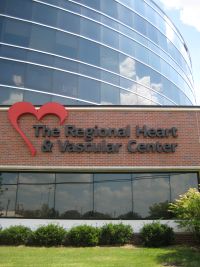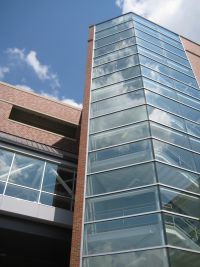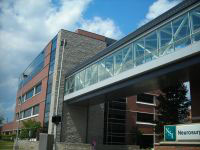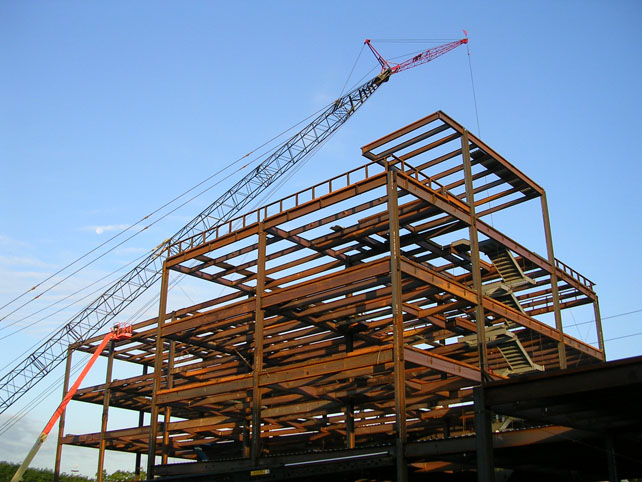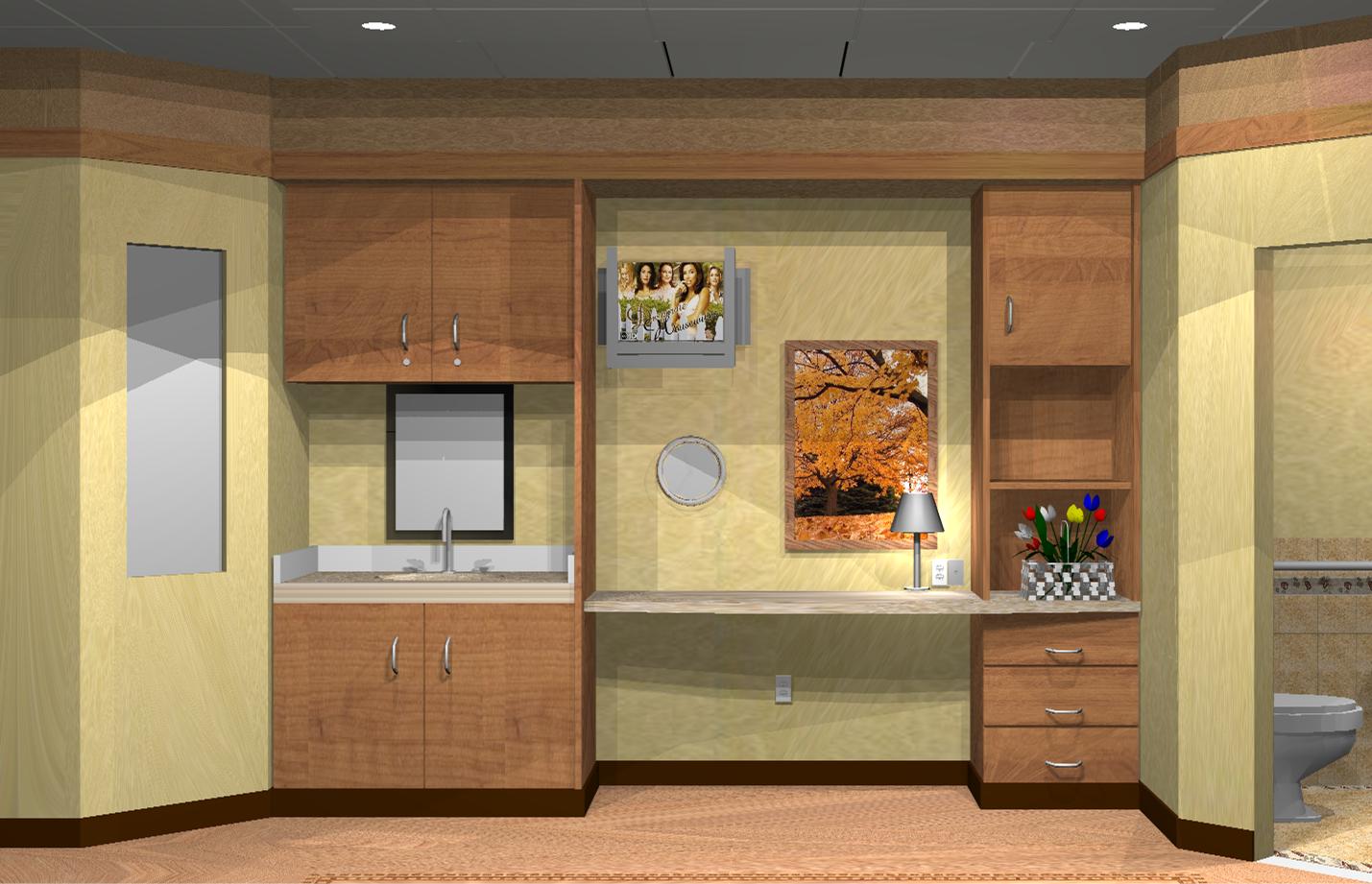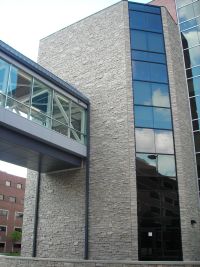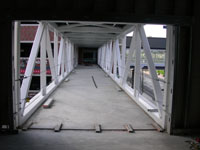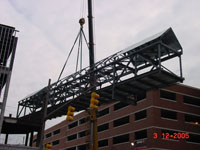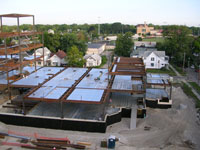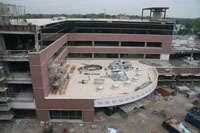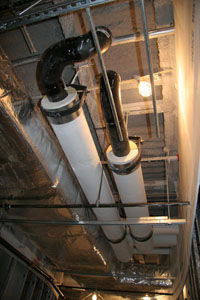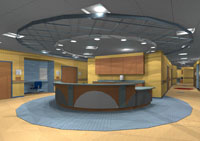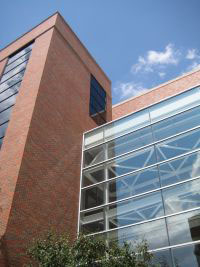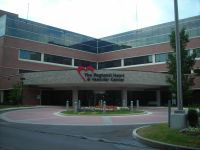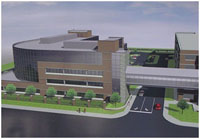
ST. VINCENT MERCY MEDICAL CENTER HEART PAVILION
TOLEDO, OH
| |
| BUILDING STATISTICS |
| THESIS ABSTRACT |
| TECHNICAL ASSIGNMENTS |
| THESIS RESEARCH |
| THESIS PROPOSAL |
| PRESENTATION |
| FINAL REPORT |
| REFLECTION |
| E-STUDIO HOMEPAGE |
| Note: While great efforts have been taken to provide accurate and complete information on the pages of CPEP, please be aware that the information contained herewith is considered a work‐in‐progress for this thesis project. Modifications and changes related to the original building designs and construction methodologies for this senior thesis project are solely the interpretation of Kristen Lechner. Changes and discrepancies in no way imply that the original design contained errors or was flawed. Differing assumptions, code references, requirements, and methodologies have been incorporated into this thesis project; therefore, investigation results may vary from the original design. |
Building Statistics
Contents:
- Building Name: St. Vincent Mercy Medical Center Heart Pavilion
- Building Location: 2400 Cherry St. Toledo, OH. at the intersection of Cherry St. and Mark St.
- Building Occupant Name: St. Vincent Mercy Medical Center
- Occupancy Type: Hospital
- Size: 144,000 SF
- Number of Stories: 4 ; 57’5” to top of steel
5604 N. Main St. Suite 200
Sylvania, OH 43560
860 Curtis St.
P.O. Box 964
Toledo, OH 43697
921 Galena St.
Toledo, OH 43611
2015 Pickle Rd.
Oregon, OH 43616
3135 N. Centennial Rd.
Sylvania, OH 43560
444 Laskey Rd., Sec. S
Toledo, OH 43612
1810 North 12th St.
Toledo, OH 43624
3254 Hill Avenue
Toledo, OH 43604
7904 Airport Hwy.
Holland, OH 43528
Dates of Construction: Summer 2005- Spring 2007
Actual Cost Info: $45 Million
Project Delivery Method: Design-Build
- Description:
St. Vincent Mercy Medical Center Heart Pavilion is a four story hospital that provides diagnostics, surgery, and patient care. It was constructed for St. Vincent’s Mercy Medical Center Campus, established in 1855, in downtown Toledo, Ohio.
St. Vincent’s Heart Pavilion is one of the seven hospitals that comprise Mercy Health Partners. As Toledo’s first and only facility for the treatment of vascular disease, St. Vincent’s Heart Pavilion has become a staple within the community. St. Vincent’s Mercy Medical Center Campus is now able to take a leadership role in providing education to its students as well as saving lives through the treatment of vascular disease.
Architectural considerations are centered around the patients’ needs. With bed-side check in, patients are able to be taken directly to their room in every effort to make their stay comfortable. The facility is set up in such a manner that patients do not have to change rooms during the duration of their stay and accommodations for visitors staying the night are available in every room. Patient rooms are private and spacious with large windows that provide a great view to the outside, creating a positive mood within the space.
- Applicable Codes:
2002 Ohio Building Code
2002 Ohio Plumbing Code
2002 Ohio Mechanical Code
1998 NFPA (National Electric Code)
2000 Life Safety Code NFPA 101
2001 Guidelines for Design and Construction of Hospital and Healthcare Facilities
- Historical/Zoning:
St. Vincent Mercy Medical Center falls within the R-5 Zoning District for the city of Toledo.
- Building Envelope:
Modernization is emphasized through the façade of St. Vincent Mercy Medical Center Heart Pavilion. As one approaches the building from the North, a beautiful curtain wall composed of curved aluminum and spandrel glass is seen, thus adding great verticality to the building. As the eye gazes along the façade, stone bands and brick veneer promote horizontal progression to an attractive vertical component of stairs wrapped in stone veneer and spandrel glass. The eye is then led to the pedestrian bridge, connecting the Heart Pavilion to a parking garage, which shows off its structure through exposed chevron bracing.
The roof envelope is surrounded by a parapet wall. The roof system is made up of two systems: 1 ½” x 22 GA. galvanized steel roof deck providing enclosure to the building, and 6 ½” normal weight concrete on 1 ½” 20 GA. galvanized metal deck providing support for the mechanical equipment located in the penthouse. Both systems are topped with a single ply membrane, ¾” plywood, and a minimum of 3” rigid insulation.
- Structural:
St. Vincent Mercy Medical Center Heart Pavilion’s typical floor system is made up of composite steel framing and normal weight concrete, creating a total floor thickness of 6 ½”. Composite action is created by the use of 2” 20 gauge steel deck with 5 ½” long, ¾” diameter shear studs evenly spaced over the length of each beam. Even though a composite system is used, the girders are actually non-composite. In order to avoid coping of the infill beams, the girders are placed 2” higher than the beams on a typical floor and 1 ½” higher on the roof. This system saved money and fabrication time which resulted in faster steel erection. In addition to these benefits, the deck connection to the girder automatically provides a pour-stop, making placement of the concrete easier.
In a typical bay, W16X26 beams span 30’ and are spaced approximately 8’-4” center to center. These beams frame into W24X68 girders via a single, bolted-bolted, angle connection. Column sizes vary from W10 to W12 depending on their location within the building. While these sizes may seem large based purely on gravity, each column must resist induced moment since all columns are part of a moment connection. Pipe columns are used to support the roof for the main entrance lobby and the emergency vestibule canopy. All of the main building columns are spliced at the 2nd-3rd floor. Base plates range in thickness from 1” to 2 ¼” depending on which columns they are supporting. Each base plate utilizes a standard 4 bolt connection using either ¾” A325 or 1 ¼” A325 bolts.
At the time of design, braced frames were thought to be architecturally incompatible with this floor plan. As a result, steel moment frames were used for the lateral load resisting system. The moment frames are connected in two different fashions as seen in Figure 2 and 3 below. The beam to column web moment connection is comprised of flange plates that are fillet welded to the column web and flange. The beam flanges are full-penetration welded to these plates. The beam to column flange moment connection utilizes double angles connecting the beam to the column flange, where the column flange is then full penetration welded to the beam flange.
The roof system is comprised W14x22 beams framing into W18X40 girders. This system was used as opposed to joists because surgery space was originally located directly below the main roof. The mechanical/medical equipment required for these spaces is easier to hang from wide flange beams.
The foundation system is made up of 80 drilled caissons and 6 spread footings that support the entrance lobby. The caisson caps are a uniform size of 4’x4’x3’ thick. Between caissons are grade beams, varying in depth from 2’-4’ depending on the location, which transfer façade and wall load to the foundation system. The ground (main) floor rests on a 6” concrete slab reinforced with W/4x4-W4.0x4.0 welded wire fabric.
- Construction:
The construction of St. Vincent Mercy Medical Center Heart Pavilion started in the late summer of 2005 and was completed in the spring of 2007. The general contractor was The Lathrop Company (now Turner Construction) and was delivered as design-build.
From the time of design, the construction schedule was a priority. Matching the height of the deck, the structural engineers placed all girders 2” higher than the beams on a typical floor and 1 ½” higher on the roof. This design saved money due to the fact that the infill beams no longer required coping. Steel was erected much quicker as a result of saved fabrication time. In addition to these benefits, the deck connection to the girder automatically provides a pour-stop, making placement of the concrete easier.
- Mechanical:
A forced air system is utilized for this facility, employing chilled water, heating water, and steam to condition all spaces. Three medium pressure rooftop air handlers supply a total of 134,000 CFM to the main hospital. In order to obtain acceptable humidity levels for a hospital space, each rooftop unit is equipped with a humidifier.
As a high level of zoning is required by hospital guidelines, air is distributed via a medium pressure duct system to a series of VAV (Variable Air Volume) and CAV (Constant Air Volume) terminal units. Each terminal unit has a reheat coil to maintain space temperature. A hot water ceiling radiant panel system supplements the heating of the space.
Each operating room is supplied by a dedicated air handling unit with a humidifier. Air is supplied to the space with a Price HORD air distribution system. Heat is supplied by three 210 GPM boilers. Two of these boilers are primarily used, while the additional boiler is used for backup. Steam for humidification, domestic water, and sterilization is provided by two (one primary and one backup) 2940 MBH 60 psi steam boilers. Chilled water is supplied by two 375 ton chillers with a 750 ton cooling tower on the roof.
- Electrical & Lighting:
The main hospital across the street supplies normal and emergency power to St. Vincent Mercy Medical Center Heart Pavilion via a 15kV underground concrete duct bank. The 15kV normal feeder is actually two feeds, each of which is capable of supplying all necessary power to the hospital under normal operating conditions and feeds a double ended substation. Dual feeds are utilized for two reasons: they provide redundancy in the electrical system in the event of a failure of one feeder, and they provide a way for periodic maintenance of the breakers on either end of the feeders. The emergency feeder feeds a single ended substation. Each substation is equipped with a transformer that steps the voltage down from 12,470V to 480Y/277V. From there the power is distributed to the chillers and automatic transfer switches.
For the use of lights and receptacles throughout the building, the voltage is further stepped down to 208Y/120V by large central transformers located in the basement. Also located in the basement are two uninterruptible power systems (UPS). These systems are very important as they provide power to operating rooms and telecommunication rooms during the event of an outage as the emergency generators are brought online.
Various types of light fixtures were used throughout the building. Linear fluorescent and compact fluorescent lamps are the primary lamps seen throughout the facility. The corridors utilize 2'x2' direct/indirect fixtures and 24" diameter acrylic bowl fixtures. Wall sconces are placed on either side of the caregiver stations which are located between the patient rooms. Compact fluorescent downlights and a 2'x4' multi-function fixture are placed over patients’ beds. The multi-function fixture provides exam, ambient, and reading light that can be controlled either by wall switches or the pillow speaker.The operating rooms are lit by a ring of six lamp 2' x 4' surgical troffers with asymmetric lenses. These fixtures focus light on the surgical table with the help of three additional surgical lights. The main lobby is primarily lit by 2'x2' direct/indirect fixtures and is centered about a large circular sky light. Accenting the sky light are curvable fluorescent strip lights mounted in a recessed cove around the skylight. Illuminating the sky light from the interior are 4 metal halide indirect luminaries.
- Fire Protection:
St. Vincent Mercy Medical Center is protected against fire through utilization of automatic sprinklers. In case of an emergency, interior spaces make use of a wet pipe system while the loading dock and the area under the entrance canopy is protected by a dry pipe system. In addition to sprinklers, all spaces within the facility contain fire alarms and smoke detectors. Smoke detectors were also provided within the ductwork.
Fire alarm pull stations are located at exits and nurses’ stations.
Under type 1B construction, SVMMC’s fire resistance ratings include 2 hours for floor assemblies, 1 ½ hours for roof assembly (fire proofing on beams and deck), and 2 hours for floor, roof, and tubular columns. Most walls within the building are rated for 2 hour fire protection.
- Transportation:
The main entrance into St. Vincent Mercy Medical Center Heart Pavilion is located off Cherry Street. A greeter’s desk is located directly inside the main lobby. Located on the east and south sides of the building are two main stairwells and four elevators that run the entire height of the building. An additional elevator and stairwell at the far east end of the building are dedicated for staff as they provide access to offices, cleaning, and decontamination space.
- Telecommunications:
The building is wired with Category-5E and Category-6 cabling for voice and data communications respectively and has both a wireless phone and wireless data network throughout. Cable tray is installed above the ceilings in all of the main corridors for routing of low voltage cabling. Card readers were installed to limit access to the patient floors and other specific areas. CCTV cameras were provided for monitoring of entries and elevator lobbies.
Bed side pull stations with call cords are located in all patient rooms and bathrooms in the event that immediate assistance is needed. For additional comfort of the occupants, cable television outlets will be supplied in patient rooms and waiting spaces.Magnetic door locks, card readers, and local intercom systems will be provided in efforts to restrict access to private spaces, such as operating rooms and staff supply rooms.
- Miscellaneous:
No additional special conditions or elements are in place at this time.
|
Senior Thesis | The Pennsylvania State University | Architectural Engineering | AE Labs | Contact Kristen |
This page was last updated on September 10, 2008 by Kristen Lechner and is hosted by the AE Department © 2009
